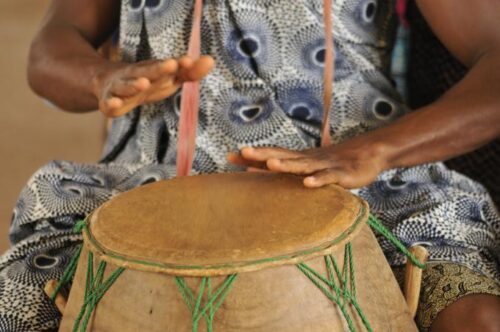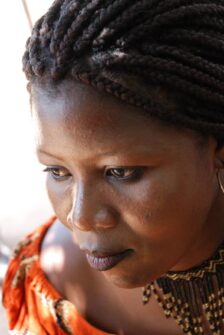Ghana. Akwasidae, an Ashanti Festival of Rich Cultural Heritage.
It is the most important event celebrated by the Chiefs and people of Ashanti in the central part of Ghana. We attend the celebration.
It is a magnificent celebration centred on ancestral reverence, remembrance and acknowledgment of past kings and noble feats. It marks the sheer magnificence of the golden heritage of the Ashanti people. Between 1697 and 1699, the Battle of Feyiase, otherwise known as the Ashanti war of independence, was an occasion to re-affirm indivisibility. Akwasidae serves as a celebration of the Golden Stool and a cultural vibrancy that brings together the Asantehene, sub-kings and subjects at Manhyia in Kumasi. The Akwasidae celebration is indeed an eventful spectacle, where the spiritual meets the physical. Ashanti culture centres on ancestral worship. The festival is also known to honour the Ashanti independence war. It is celebrated on a Sunday, once in every six weeks. The importance of the celebration of Akwasidae festival is next only to the National Day celebrations.

Akwasidae Celebration in Manhyia Palace. CC BY-SA 4.0/Zack Agon
In Akan, ‘adae’ means ‘place of rest’, and as such Akwasidae is when past kings are called upon to invoke their blessings on the people. Prior to Akwasidae, the preceding Saturday evening, known as Memeneda Dapaa, sees elderly women of the Stool conveying emblematic songs to the palace grounds. Drums and horns voice out harmonies and dancing goes on until the early hours of the morning, inviting the spirits of the dead. One place to learn more about the event is the Manhyia Museum.
The traditions of the Akwasidae festival are connected with the Akan annual calendar which is divided into nine parts. Each part lasts approximately six weeks (between 40–42 days in a period). The celebration of this period is called the ‘Adae’ festival. The ‘Adae’ Festival has two celebration days: the Akwasidae festival which is celebrated on the final Sunday of the period and the Awukudae festival that is celebrated on a Wednesday within the period.

The Friday preceding 10 days to the Akwasidae is called Fofie, which means a ritual Friday. During the last Akwasidae of the year, which coincides with the Adae Kese Festival, special attention is given to making food offerings and donations for helping people. The festivals of Adae are not interchangeable as they were fixed from ancient times.
The festival adores the milestones in the history of the Ashanti Kingdom. Its first celebration was during the attainment of statehood by the Ashanti Kingdom after it had defeated the Denkyiras in the battle of Feyiase, also known as the Ashanti independence war.
During the Akwasidae festival, the rich cultural heritage of the Ashanti people is displayed to attract local people and foreign visitors. The Ashanti kingdom is made up of social groups led by clan heads, compelled to connect the life force of the past and the people. Due to the rich nature of the event, the festival takes place in the royal palace and gathers thousands of people, all dressed in traditional costumes.
The ceremony opens in the throne room, where only the initiates are allowed. According to the Ashanti cultural archive records, Akwasidae is an ornate ceremony, commemorating the date that the Ashanti Golden Stool was magically brought down from heaven.

The Golden Stool symbolizes solidarity within the Ashanti kingdom.
The Golden Stool is historic and arguably the most sacred symbol commanded from the sky by Okomfo Anokye, into the lap of Asantehene Osei Tutu during the 17th century. The stool stands 18 inches high, 24 inches long and 12 inches wide and is never allowed to come into contact with earth or be used as a seat. Every new king is lowered and raised over the Golden Stool without ever touching it. At Akwasidae, the Asantehene sits in close proximity to the installed Golden Stool. Since its introduction, the Golden Stool has always symbolised solidarity within the Ashanti kingdom.
Ritual libations of blood and schnapps (gin) are poured onto the thrones of the former kings as offerings to them and to the ancestors. The belief is that the blood revitalizes the stools and the ancestral spirits, and the lungs; a symbol of breath of life serves the purpose of giving new life to the stools. During the last Akwasidae of the year, special attention is given to making food offerings and donations for helping people.
Food offerings include special items such as etor (mashed African yam) mixed with boiled eggs.

Ashanti local chiefs. CC BY-SA 2.0/ Erik Kristensen
On this day, the Asantehene (King of Asantes) is called upon to oversee the pledging of allegiance to the Golden Stool, arguably the most sacred symbol within the Ashanti Kingdom. He meets his subjects and subordinate chiefs in the courtyard of the Manhyia Palace. The Golden Stool (throne) is displayed at the palace grounds in the presence of the King. People sing and dance while the King holds his durbar on the occasion of the festival. During that period, people are at liberty to shake hands with their King.
The King leads a procession in a palanquin decorated with gold jewellery and he sits under a large bright umbrella. He also witnesses a colourful parade from his palace grounds at Kumasi. Participants of the parade include drum beaters, folk dancers, horn-blowers, and singers. The arrival of the Asantehene at the durbar grounds is heralded by a retinue of courtiers led by a man carrying a brass pan containing talisman and herbs believed to drive away evil spirits.

Ashanti woman.
Others carry the traditional sandals of silver and gold keys (the Nsafoahene). The key, in folklore, signifies that when the Asantehene is out of the palace all doors are shut. The Asantehene emerges holding a traditional sword in one hand and a whisk in another and dances to traditional music and steps out of the palanquin. As the procession passes, he bows gently to the chiefs and other subjects to acknowledge their presence.
As it is a festival of paying respect to ancestors, the Asantehene (king) visits the Bantama Mausoleum and offers worship not only to his ancestors’ chairs (stools), but also to the skeletal remains of his ancestors. He pays respect to the honour of Abosom (lesser gods in the Akan tradition) and Nsamanfo (spiritually cultivated ancestors). Concluding the ceremony in the mausoleum, the paramount chief orders drinks to be served to all present who later depart, leaving the stools and the ancestors to eat and drink what has been served them.
In front of the King stand other chiefs in the shade of their umbrellas, sword carriers, bearers of ritual knives, armed guards with loaded rifles and nobles with ostrich feather fans. Sitting next to the King are the dignitaries of the court. The royal speaker stands by the King’s side and holds in his hands a golden scepter as a symbol of the Asantehene’s (King) power.The Queen mother, the most important woman in the realm, is also present and surrounded by her court made up exclusively of women. To accompany the ceremony, glorious stories are told of the past Ashanti Kings, musicians play drums and ivory horns giving the rhythm to the ceremony and women wrapped in bright red clothes dance, performing traditional steps.

Akwasidae itself comes in two parts: aside from the main celebrations open to the general public there are solemn, private ceremonies, including rituals for eulogising the incumbent king and the presentation of ceremonial sacrifices to the ancestral spirits. The celebration on these days involves the purification of black, ancestral, hand-carved stools.
Public celebrations include a fine durbar of kings, queen mothers, elders and the people presided over by the Asantehene. Golden regalia, umbrellas, palanquins, and paraphernalia add to the glow interspersed with drumming and dancing from different cultural bands at the palace grounds. The enormous wealth of the Ashantis is a factor that helped to develop the society into one of the greatest in Africa to the extent that it currently stands out as the leading custodian of Ghana’s rich cultural heritage. (Open Photo: The 16th Asantehene, King of Ashanti, Otumfour Osei Tutu II. CCBY-SA 4.0/ Zackagonii)
Damian Dieu Donne Avevor



